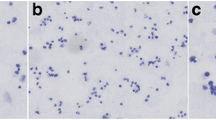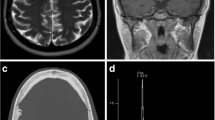Abstract
Purpose
Meningiomas are the most common extra-axial intracranial neoplasms with typical radiological findings. In approximately 2% of cases, histopathological reports reveal different neoplasms or non-neoplastic lesions that can closely mimic meningiomas. We describe radiological features of meningioma mimics highlighting imaging red flags to consider a differential diagnosis.
Methods
A total of 348 lesions with radiological diagnosis of meningiomas which underwent to surgical treatment or biopsy between December of 2000 and September of 2014 were analyzed. We determined imaging features that are not a typical finding of meningiomas, suggesting other lesions. The following imaging characteristics were evaluated on CT and MRI: (a) bone erosion; (b) hyperintensity on T2WI; (c) hypointensity on T2WI; (d) bone destruction; (e) dural tail; (f) leptomeningeal involvement; (g) pattern of contrast enhancement; (h) dural displacement sign.
Results
We have a relatively high prevalence of meningioma mimics (7.2%). Dural-based lesions with homogeneous contrast enhancement (52%) are easily misdiagnosed as meningiomas. Most lesions mimic convexity (37.5%) or parafalcine (21.9%) meningiomas. We have determined five imaging red flags that can alert radiologists to consider meningioma mimics: (1) bone erosion (22.2%); (2) dural displacement sign (36%); (3) marked T2 hypointensity (32%); (4) marked T2 hyperintensity (12%); (5) absence of dural tail (48%). The most common mimic lesion in our series was hemangiopericytomas, followed by lymphomas and schwannomas.
Conclusion
The prevalence of meningioma mimics is not negligible. It is important to have awareness on main radiological findings suggestive of differential diagnosis due to a wide range of differentials which lead to different prognosis and treatment strategies.






Similar content being viewed by others
References
Bondy M, Ligon BL (1996) Epidemiology and etiology of intracranial meningiomas: a review. J Neurooncol 29:197–205. https://doi.org/10.1007/bf00165649
Ghosal N, Dadlani R, Gupta K, Furtado SV, Hegde AS (2012) A clinicopathological study of diagnostically challenging meningioma mimics. J Neurooncol 106:339–352. https://doi.org/10.1007/s11060-011-0669-3
Starr CJ, Cha S (2017) Meningioma mimics: five key imaging features to differentiate them from meningiomas. Clin Radiol 72:722–728. https://doi.org/10.1016/j.crad.2017.05.002
Watts J, Box G, Galvin A, Brotchie P, Trost N, Sutherland T (2014) Magnetic resonance imaging of meningiomas: a pictorial review. Insights Imaging 5:113–122. https://doi.org/10.1007/s13244-013-0302-4
Johnson MD, Powell SZ, Boyer PJ, Weil RJ, Moots PL (2002) Dural lesions mimicking meningiomas. Hum Pathol 33:1211–1226. https://doi.org/10.1053/hupa.2002.129200
Smith AB, Horkanyne-Szakaly I, Schroeder JW, Rushing EJ (2014) From the radiologic pathology archives: mass lesions of the dura: beyond meningioma-radiologic-pathologic correlation. Radiographics 34:295–312. https://doi.org/10.1148/rg.342130075
Rogers L, Barani I, Chamberlain M, Kaley TJ, McDermott M, Raizer J, Schiff D, Weber DC, Wen PY, Vogelbaum MA (2015) Meningiomas: knowledge base, treatment outcomes, and uncertainties. A RANO review. J Neurosurg 122:4–23. https://doi.org/10.3171/2014.7.JNS131644
Ginsberg LE (1996) Radiology of meningiomas. J Neurooncol 29:229–238
Buetow MP, Buetow PC, Smirniotopoulos JG (1991) Typical, atypical, and misleading features in meningioma. Radiographics 11:1087–1106. https://doi.org/10.1148/radiographics.11.6.1749851
Ahn JY, Kwon SO, Shin MS, Kang SH, Kim YR (2002) Meningeal chloroma (granulocytic sarcoma) in acute lymphoblastic leukemia mimicking a falx meningioma. J Neurooncol 60:31–35. https://doi.org/10.1023/A:1020236031949
Siegelman ES, Mishkin MM, Taveras JM (1991) Past, present, and future of radiology of meningioma. Radiographics 11:899–910. https://doi.org/10.1148/radiographics.11.5.1947324
Paiva J, King J, Chandra R (2011) Extra-axial Hodgkin’s lymphoma with bony hyperostosis mimicking meningioma. J Clin Neurosci 18:725–727. https://doi.org/10.1016/j.jocn.2010.09.015
Lin C-K, Lai D-M (2013) IgG4-related intracranial hypertrophic pachymeningitis with skull hyperostosis: a case report. BMC Surg 13:37. https://doi.org/10.1186/1471-2482-13-37
Smith AB, Horkanyne-Szakaly I, Schroeder JW, Rushing EJ (2014) From the radiologic pathology archives mass lesions of the dura: beyond menin-gioma-radiologic-pathologic correlation. Radiographics 34:295–312. https://doi.org/10.1148/rg.342130075
Nagar VA, Ye JR, Ng WH, Chan YH, Hui F, Lee CK, Lim CCT (2008) Diffusion-weighted MR imaging: diagnosing atypical or malignant meningiomas and detecting tumor dedifferentiation. Am J Neuroradiol 29:1147–1152. https://doi.org/10.3174/ajnr.A0996
Lee IH, Kim ST, Kim HJ, Kim KH, Jeon P, Byun HS (2010) Analysis of perfusion weighted image of CNS lymphoma. Eur J Radiol 76:48–51. https://doi.org/10.1016/j.ejrad.2009.05.013
Zhang H, Rödiger LA, Shen T, Miao J, Oudkerk M (2008) Perfusion MR imaging for differentiation of benign and malignant meningiomas. Neuroradiology 50:525–530. https://doi.org/10.1007/s00234-008-0373-y
Meyers SP, Hirsch WL, Curtin HD et al (1992) Chondrosarcomas of the skull base: MR imaging features. Radiology 184:103–108. https://doi.org/10.1148/radiology.184.1.1609064
Wilms G, Lammens M, Marchal G, Calenbergh FV, Plets C, Fraeyenhoven LV, Baert AL (1989) Thickening of dura surrounding meningiomas: MR features. J Comput Assist Tomogr 13:763–768. https://doi.org/10.1097/00004728-198909000-00003
Wilms G, Lammens M, Marchal G et al (1991) Prominent dural enhancement adjacent to nonmeningiomatous malignant lesions on contrast-enhanced MR images. Am J Neuroradiol 12:761–764
Zhou J, Liu J, Zhang J, Zhang M (2012) Thirty-nine cases of intracranial hemangiopericytoma and anaplastic hemangiopericytoma: a retrospective review of MRI features and pathological findings. Eur J Radiol 81:3504–3510. https://doi.org/10.1016/j.ejrad.2012.04.034
Macagno N, Vogels R, Appay R, Colin C, Mokhtari K, French CNS SFT/HPC Consortium, Dutch CNS SFT/HPC Consortium, Küsters B, Wesseling P, Figarella-Branger D, Flucke U, Bouvier C (2019) Grading of meningeal solitary fibrous tumors/hemangiopericytomas: analysis of the prognostic value of the Marseille Grading System in a cohort of 132 patients. Brain Pathol 29:18–27. https://doi.org/10.1111/bpa.12613
Lyndon D, Lansley JA, Evanson J, Krishnan AS (2019) Dural masses: meningiomas and their mimics. Insights Imaging 10:11. https://doi.org/10.1186/s13244-019-0697-7
Fountas KN, Kapsalaki E, Kassam M, Feltes CH, Dimopoulos VG, Robinson JS, Smith JR (2006) Management of intracranial meningeal hemangiopericytomas: outcome and experience. Neurosurg Rev 29:145–153. https://doi.org/10.1007/s10143-005-0001-9
Ma C, Xu F, Xiao YD et al (2014) Magnetic resonance imaging of intracranial hemangiopericytoma and correlation with pathological findings. Oncol Lett 8:2140–2144. https://doi.org/10.3892/ol.2014.2503
Clarençon F, Bonneville F, Rousseau A, Galanaud D, Kujas M, Naggara O, Cornu P, Chiras J (2011) Intracranial solitary fibrous tumor: imaging findings. Eur J Radiol 80:387–394. https://doi.org/10.1016/j.ejrad.2010.02.016
Author information
Authors and Affiliations
Contributions
V.N.Y., G.A.B., L. F. S. G., L.T.L, I.S.N. and W.S.P. contributed to design and implementation of the research;
V.N.Y., G.C.L. and D.J.F.S. contributed to retrospective review of data, statistical analysis and reported results;
G.A.B., L. F. S. G. and L.T.L reviewed neuroimages and confirmed radiological signs reported on results;
V.N.Y. and L. F. S. G. wrote the paper;
W.S.P. and M.J.T. supervised the project;
All the authors critically reviewed the manuscript before submission
Corresponding author
Ethics declarations
Conflict of interest
The authors declare that they have no conflict of interest.
Ethical approval
All procedures performed in the studies involving human participants were in accordance with the ethical standards of the institutional and/or national research committee and with the 1964 Helsinki Declaration and its later amendments or comparable ethical standards.
Informed consent
Informed consent was obtained from all individual participants included in the study.
Additional information
Publisher’s note
Springer Nature remains neutral with regard to jurisdictional claims in published maps and institutional affiliations.
Rights and permissions
About this article
Cite this article
Nagai Yamaki, V., de Souza Godoy, L.F., Alencar Bandeira, G. et al. Dural-based lesions: is it a meningioma?. Neuroradiology 63, 1215–1225 (2021). https://doi.org/10.1007/s00234-021-02632-y
Received:
Accepted:
Published:
Issue Date:
DOI: https://doi.org/10.1007/s00234-021-02632-y




